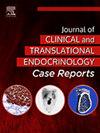A rare case of metachronous pituitary germinoma and testicular seminoma: The role of tumor markers in diagnosis and the influence of glucocorticoids on disease progression
Q4 Medicine
Journal of Clinical and Translational Endocrinology: Case Reports
Pub Date : 2025-02-06
DOI:10.1016/j.jecr.2025.100182
引用次数: 0
Abstract
The presence of both an extragonadal germ cell tumor and gonadal germ cell tumor is a rare occurrence with few cases reported in the literature. We herein report a case of a young man presenting with hypophysitis due to a pituitary germinoma. After a course of high dose glucocorticoid (GC) therapy and the surgical removal of the germinoma, a testicular seminoma was discovered, an apparently second distinct primary germ cell tumor. Hypophysitis was initially attributed to lymphocytic hypophysitis due to the largely unrevealing secondary work up that included beta-human chorionic gonadotropin (b-hCG) and alpha fetoprotein (AFP), which highlights the pitfalls of relying on the tumor marker of b-hCG in both germinomas and seminomas and the important role of biopsy for definitive diagnosis of hypophysitis etiology. Furthermore, the presentation of the seminoma following a course of high dose GC indicates that immunosuppressive therapies may promote the growth of these germ cell tumors.
求助全文
约1分钟内获得全文
求助全文
来源期刊

Journal of Clinical and Translational Endocrinology: Case Reports
Medicine-Endocrinology, Diabetes and Metabolism
CiteScore
1.10
自引率
0.00%
发文量
32
审稿时长
27 weeks
期刊介绍:
The journal publishes case reports in a variety of disciplines in endocrinology, including diabetes, metabolic bone disease and osteoporosis, thyroid disease, pituitary and lipid disorders. Journal of Clinical & Translational Endocrinology Case Reports is an open access publication.
 求助内容:
求助内容: 应助结果提醒方式:
应助结果提醒方式:


